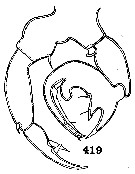|
|
 |
|
Calanoida ( Order ) |
|
|
|
Diaptomoidea ( Superfamily ) |
|
|
|
Pontellidae ( Family ) |
|
|
|
Pontella ( Genus ) |
|
|
| |
Pontella meadi Wheeler, 1901 (F,M) | |
| | | | | | | Syn.: | Pontella pennata Wilson, 1932 (p.27, figs.F,M); 1932 a (p.150, figs.F,M); Wilson, 1942 a (p.203); Grice, 1956 (p.68); 1960 (p.220);
no Pontella meadi : Chiba, 1956 (p.52, figs.M, Rem.) | | | | Ref.: | | | Wheeler, 1901 (p.180, figs.F,M): Wilson, 1932 a (p.153, figs.F,M); 1950 (p.295, figs.F,M); Fleminger, 1957 (p.26: Rem.); Silas & Pillai, 1973 (1976) (p.776, 834); Chen & Marcus, 1997 (p.587, Rem: egg) |  issued from : C.B. Wilson in Bull. U.S. natn Mus., 1950, 100 (14) (4). [Plate 28, 417-418]. Female (from Gulf of Mexico): 417, habitus (dorsal); 418, P5. When alive or freshly preserved there is a row of dark blotches, one on each segment, along the dorsal midline of the metasome.
|
 issued from : C.B. Wilson in Bull. U.S. natn Mus., 1950, 100 (14) (4). [Plate 28, 419]. Male: 419, P5.
| | | | | Compl. Ref.: | | | Wilson, 1932 (p.26); Dawson, 1966 (p.176); Sherman & Schaner, 1968 (p.583, fig.1); Grice & Gibson, 1977 (p.410, resting eggs); Turner, 1977 (p.249, fecal pellets); 1979 (p.131, fecal pellet/microbial); Turner & al., 1979 (p.289, Tab.3, fecal pellets); Grice & Marcus, 1981 (p.125, Dormant eggs, Rem.: p.134); Madhupratap & al., 1996 (p.77, Table 2: resting eggs); Marcus, 1996 (p.144); Suarez-Morales & Gasca, 1997 (p.1525); Mauchline, 1998 (tab.40, 47); Suarez-Morales & Gasca, 1998 a (p.110); Frangoulis & al., 2005 (p.254, Table I: C/N/P fecal pellet composition) | | | | NZ: | 2 | | |
|
Distribution map of Pontella meadi by geographical zones
|
| | |  issued from : J.T. Turner in Mar. Biol., 1977, 40. [p.254, Fig.3]. Pontella meadi from estuarine waters near Galveston (Texas). issued from : J.T. Turner in Mar. Biol., 1977, 40. [p.254, Fig.3]. Pontella meadi from estuarine waters near Galveston (Texas).
3: Fecal pellet produced on Skeletonema costatum plus Nitzschia sp. diet; 4: high magnification of area in square in 3.
Nota: Sinking rates of fecal pellets produced by the species, grazing on 4 different phytoplankton diets, ranged from 15 to 153 m/day, with a mean of 66 m/day.
In 1979, Turner (1979, p.249) points to that pellets were colonized by rod-shaped bacteria that became attached to the outside of the peritrophic membrane and were not of intestinal origin. |
| | | | Loc: | | | Caribbean, Yucatan, Yucatan (Ascension Bay), G. of Mexico, Galveston Bay (Texas), Louisiana (off Grand Isle, Turkey Point), Florida, Chesapeake Bay, Woods Hole, Georges Bank | | | | N: | 16 | | | | Lg.: | | | (45) F: 2,65-2,35; M: 3-2,75; (45’) F: 3,25-3; M: 3,5-3; (632) F: 3,5-3; M: 3,25-2,85; {F: 2,35-3,50; M: 2,75-3,50} | | | | Rem.: | approaching a Pontella lobiancoi.
Wheeler describes this species from Woods Hole Harbour.
After Grice & Gibson (1977, p.410) the species, at Vineyard Sound and Buzzards Bay, produces resting eggs in fall which hatch the following summer and repopulate temperate inshore areas. Resting eggs have been shown to occur in bottom sediment in winter. | | | Last update : 02/10/2020 | |
|
|
 Any use of this site for a publication will be mentioned with the following reference : Any use of this site for a publication will be mentioned with the following reference :
Razouls C., Desreumaux N., Kouwenberg J. and de Bovée F., 2005-2025. - Biodiversity of Marine Planktonic Copepods (morphology, geographical distribution and biological data). Sorbonne University, CNRS. Available at http://copepodes.obs-banyuls.fr/en [Accessed November 30, 2025] © copyright 2005-2025 Sorbonne University, CNRS
|
|
 |
 |






